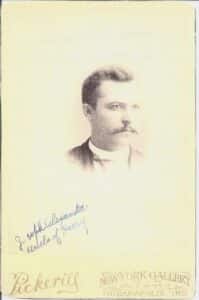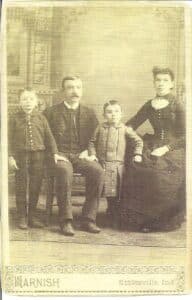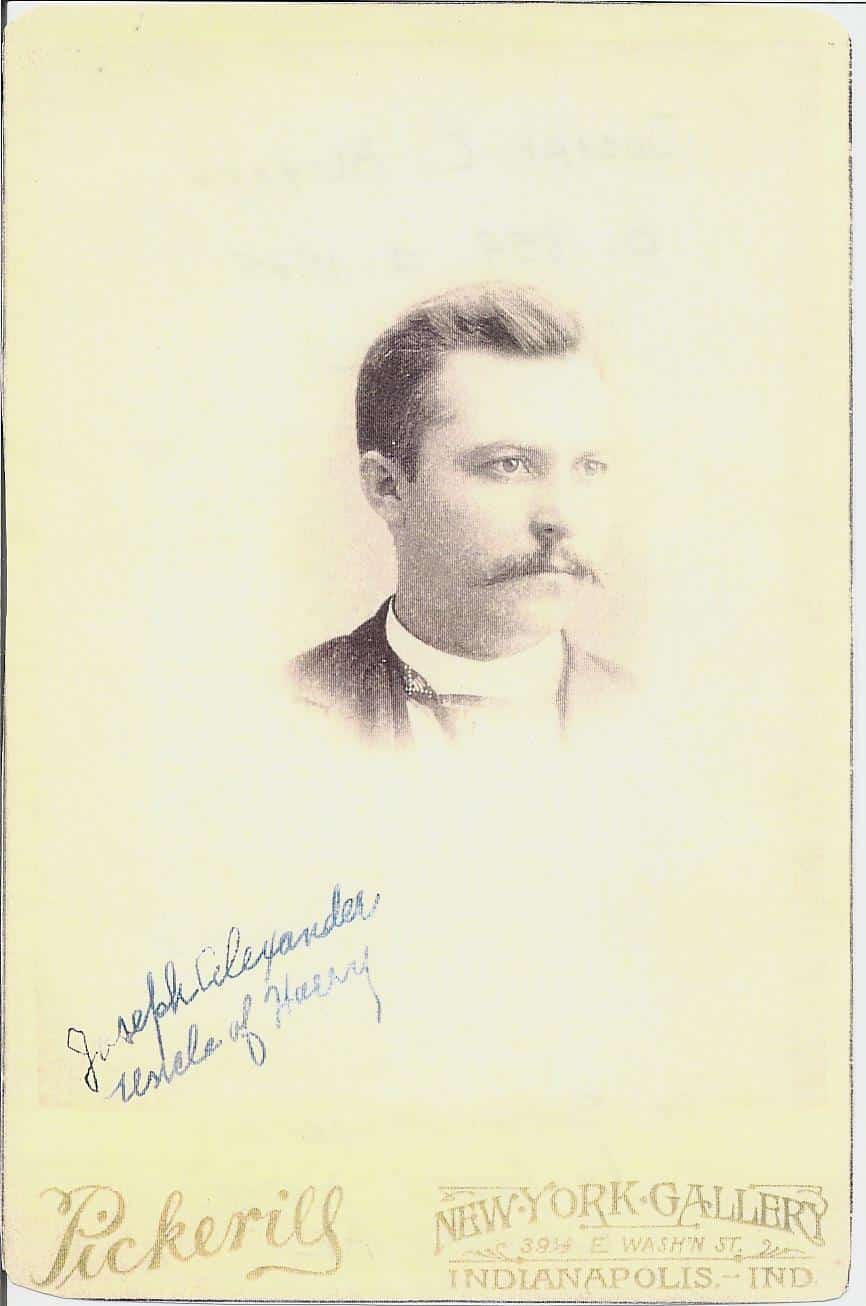Grave Robbing in Fishers- Part 2
By: David Heighway, Hamilton County Historian
 The other Fishers person involved in the turn-of-the-century grave robbing trials had a very different life than that of Hamp West. Dr. Joseph C. Alexander was born in Hamilton County, Indiana, in 1859. His father died that same year and his mother died in 1866.[i] Alexander lived on various relatives’ farms until he turned eighteen, when he became a schoolteacher. During the summers, he worked in a blacksmith shop, a carpenter’s shop, and a drugstore. He was well-liked and respected in the community. However, in 1884, he was arrested for the illegal sale of liquor but was acquitted. After seven or eight years of teaching, he decided to attend college and become a doctor. He moved to Indianapolis and worked several jobs to pay for his schooling, finally graduating from the Indiana Medical School in 1895. He opened an office in Noble Street in Indianapolis, later moving to the Claypool Building. He became associated with the Central College of Physicians and Surgeons in 1901, delivering lectures on osteopathy. In June of 1902, he was appointed director of the anatomical laboratory in their newly completed building.[ii]
The other Fishers person involved in the turn-of-the-century grave robbing trials had a very different life than that of Hamp West. Dr. Joseph C. Alexander was born in Hamilton County, Indiana, in 1859. His father died that same year and his mother died in 1866.[i] Alexander lived on various relatives’ farms until he turned eighteen, when he became a schoolteacher. During the summers, he worked in a blacksmith shop, a carpenter’s shop, and a drugstore. He was well-liked and respected in the community. However, in 1884, he was arrested for the illegal sale of liquor but was acquitted. After seven or eight years of teaching, he decided to attend college and become a doctor. He moved to Indianapolis and worked several jobs to pay for his schooling, finally graduating from the Indiana Medical School in 1895. He opened an office in Noble Street in Indianapolis, later moving to the Claypool Building. He became associated with the Central College of Physicians and Surgeons in 1901, delivering lectures on osteopathy. In June of 1902, he was appointed director of the anatomical laboratory in their newly completed building.[ii]
Even before Dr. Alexander came to the College of Physicians and Surgeons, the school had been accused of body snatching. In February of 1898, while police officers searched the college for the body of a young man (whom they never found), they unexpectedly found the body of an elderly woman who was known to one of the officers. The college proclaimed its innocence, but, after some strong words and a near-fight, finally allowed the body to be taken and reburied.[iii]
The situation intensified in October of 1901 when two more stolen bodies were found at the college. In one case the officials asserted their innocence (again) and in the other, they insisted that they had found the body tied in a sack on their front steps and were merely holding it for identification.[iv] The authorities were neither fooled nor amused. About this time the city appointed two detectives to investigate these incidents. Their first clue would come from an odd source.
 In September of 1902, a Market Street gunsmith swore a writ of replevin for four shotguns that had been purchased from him and then pawned. He said four men had bought the guns with a partial payment, and a third party had guaranteed the rest. The guarantor was listed as Dr. Joseph Alexander. One of the four men was Rufus Cantrell who was arrested and questioned. When the police offered him leniency, he confessed to grave robbing and said the shotguns were purchased to use in case they were discovered while at their work in a cemetery. He implicated Dr. Alexander in everything, along with some other doctors. The police then arrested Alexander and charged him with disturbing a grave, taking a corpse, and aiding in the concealment of a corpse. The doctor issued an immediate denial.[v] However, on October 12, four bodies were actually found on the street tied up in sacks. Since they were found a few blocks from the Central College of Physicians and Surgeons, some educated guesses were made.[vi]
In September of 1902, a Market Street gunsmith swore a writ of replevin for four shotguns that had been purchased from him and then pawned. He said four men had bought the guns with a partial payment, and a third party had guaranteed the rest. The guarantor was listed as Dr. Joseph Alexander. One of the four men was Rufus Cantrell who was arrested and questioned. When the police offered him leniency, he confessed to grave robbing and said the shotguns were purchased to use in case they were discovered while at their work in a cemetery. He implicated Dr. Alexander in everything, along with some other doctors. The police then arrested Alexander and charged him with disturbing a grave, taking a corpse, and aiding in the concealment of a corpse. The doctor issued an immediate denial.[v] However, on October 12, four bodies were actually found on the street tied up in sacks. Since they were found a few blocks from the Central College of Physicians and Surgeons, some educated guesses were made.[vi]
On October 26, a grand jury returned twenty-five indictments. Besides Alexander, four physicians from other schools were indicted. Although several other colleges were investigated, the only other schools mentioned in the indictments were the Eclectic Medical College and the Physio-Medical College.[vii] The trial began February 2, 1903. The star witness of the prosecution was Rufus Cantrell who had been nicknamed “the King of the Ghouls” by the popular press. While his testimony was fairly damning, the defense countered with Cantrell’s psychological history. The real damage to Dr. Alexander’s case, however, came from the testimony by various pawnbrokers and merchants that he had paid in person for things that Cantrell had bought.[viii]
On February 12, the final arguments were made and the jury recessed to make their decision. This was an extremely controversial case with a great deal of pressure on the jury. The atmosphere in the jury room was intense. There were violent arguments as the vote tally went back and forth. One juror had a heart attack. The vote tended to run 8 to 4 to convict, but a consensus was impossible. Finally after 48 hours with no progress, the judge declared a hung jury and discharged them.[ix] The prosecutor dropped the charges against Dr. Alexander on April 11, 1903. Although further action was threatened, it seemed unlikely. Dr. Alexander eventually reopened his practice in 1915 and died in 1925.[x] He is buried at Crown Hill Cemetery in Indianapolis – curiously without a headstone.
[i] Email from Susan Alexander, October 19, 2003.
[ii] Indianapolis Sentinel, February 11, 1903, p.1.
[iii] Sentinel, February 13, 1898.
[iv] Sentinel, November 15, 1901.
[v] Sentinel, September 30, 1902.
[vi] Sentinel, October 26, 1902.
[vii] Ibid.
[viii] Sentinel, February 5, 1903.
[ix] Sentinel, February, 13, 15, 17, 1903
[x] Directory of deceased American physicians, 1804-1929, American Medical Assoc., Chicago, Ill., 1993, p. 15.
